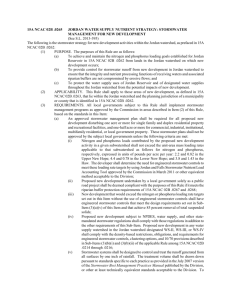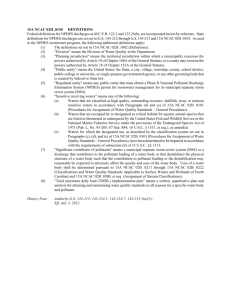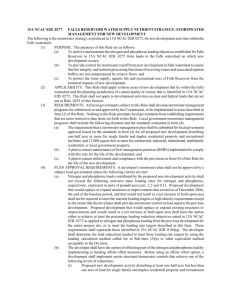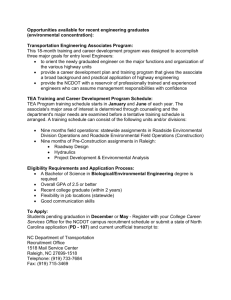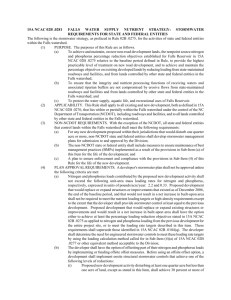DOC - ncrules.state.nc.us
advertisement
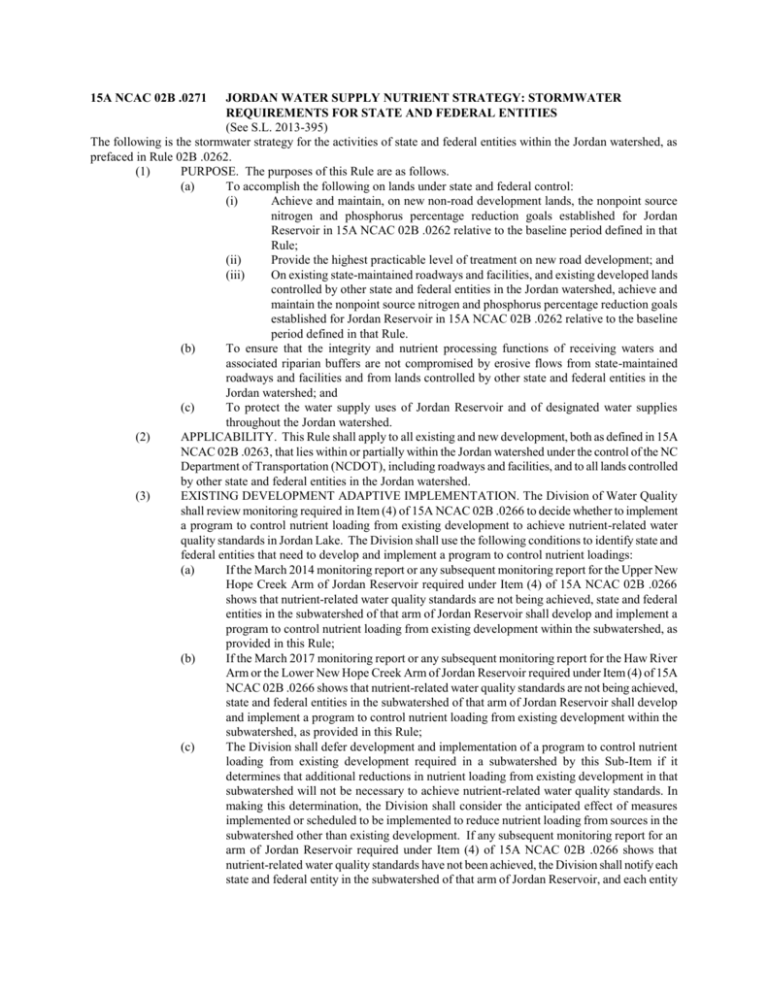
15A NCAC 02B .0271 JORDAN WATER SUPPLY NUTRIENT STRATEGY: STORMWATER REQUIREMENTS FOR STATE AND FEDERAL ENTITIES (See S.L. 2013-395) The following is the stormwater strategy for the activities of state and federal entities within the Jordan watershed, as prefaced in Rule 02B .0262. (1) PURPOSE. The purposes of this Rule are as follows. (a) To accomplish the following on lands under state and federal control: (i) Achieve and maintain, on new non-road development lands, the nonpoint source nitrogen and phosphorus percentage reduction goals established for Jordan Reservoir in 15A NCAC 02B .0262 relative to the baseline period defined in that Rule; (ii) Provide the highest practicable level of treatment on new road development; and (iii) On existing state-maintained roadways and facilities, and existing developed lands controlled by other state and federal entities in the Jordan watershed, achieve and maintain the nonpoint source nitrogen and phosphorus percentage reduction goals established for Jordan Reservoir in 15A NCAC 02B .0262 relative to the baseline period defined in that Rule. (b) To ensure that the integrity and nutrient processing functions of receiving waters and associated riparian buffers are not compromised by erosive flows from state-maintained roadways and facilities and from lands controlled by other state and federal entities in the Jordan watershed; and (c) To protect the water supply uses of Jordan Reservoir and of designated water supplies throughout the Jordan watershed. (2) APPLICABILITY. This Rule shall apply to all existing and new development, both as defined in 15A NCAC 02B .0263, that lies within or partially within the Jordan watershed under the control of the NC Department of Transportation (NCDOT), including roadways and facilities, and to all lands controlled by other state and federal entities in the Jordan watershed. (3) EXISTING DEVELOPMENT ADAPTIVE IMPLEMENTATION. The Division of Water Quality shall review monitoring required in Item (4) of 15A NCAC 02B .0266 to decide whether to implement a program to control nutrient loading from existing development to achieve nutrient-related water quality standards in Jordan Lake. The Division shall use the following conditions to identify state and federal entities that need to develop and implement a program to control nutrient loadings: (a) If the March 2014 monitoring report or any subsequent monitoring report for the Upper New Hope Creek Arm of Jordan Reservoir required under Item (4) of 15A NCAC 02B .0266 shows that nutrient-related water quality standards are not being achieved, state and federal entities in the subwatershed of that arm of Jordan Reservoir shall develop and implement a program to control nutrient loading from existing development within the subwatershed, as provided in this Rule; (b) If the March 2017 monitoring report or any subsequent monitoring report for the Haw River Arm or the Lower New Hope Creek Arm of Jordan Reservoir required under Item (4) of 15A NCAC 02B .0266 shows that nutrient-related water quality standards are not being achieved, state and federal entities in the subwatershed of that arm of Jordan Reservoir shall develop and implement a program to control nutrient loading from existing development within the subwatershed, as provided in this Rule; (c) The Division shall defer development and implementation of a program to control nutrient loading from existing development required in a subwatershed by this Sub-Item if it determines that additional reductions in nutrient loading from existing development in that subwatershed will not be necessary to achieve nutrient-related water quality standards. In making this determination, the Division shall consider the anticipated effect of measures implemented or scheduled to be implemented to reduce nutrient loading from sources in the subwatershed other than existing development. If any subsequent monitoring report for an arm of Jordan Reservoir required under Item (4) of 15A NCAC 02B .0266 shows that nutrient-related water quality standards have not been achieved, the Division shall notify each state and federal entity in the subwatershed of that arm of Jordan Reservoir, and each entity (4) (5) shall develop and implement a program to control nutrient loading from existing development as provided in this Rule; and (d) ADDITIONAL MEASURES TO REDUCE NITROGEN LOADING IN THE UPPER NEW HOPE CREEK SUBWATERSHED. If the March 1, 2023, monitoring report or any subsequent monitoring report for the Upper New Hope Creek Arm of Jordan Reservoir shows that nutrient-related water quality standards are not being achieved, state and federal entities located in whole or in part in the Upper New Hope Creek Subwatershed shall modify their programs to control nutrient loading from existing roadway and nonroadway development to achieve additional reductions in nitrogen loadings. The modified program shall be designed to achieve a total reduction in nitrogen loading from existing development of 35 percent relative to the baseline period 1997 through 2001 in that arm of Jordan Reservoir. Subject state and federal entities shall develop and implement a program to control nutrient loading from existing development within the subwatershed, as provided in this Rule. EXISTING DEVELOPMENT NOTIFICATION REQUIREMENTS. Based on findings under Item (3) of this Rule, the Division shall notify the state and federal entities in each subwatershed that either: (a) Implementation of a program to control nutrient loading from existing development, or additional measures under an existing program, will be necessary to achieve water quality standards in an arm of the reservoir and direct the state and federal entities in the subwatershed to develop or modify a load reduction program in compliance with this Rule; or (b) Implementation of a program to control nutrient loading from existing development is not necessary at that time but will be reevaluated in three years based on the most recent water quality monitoring information. NON-NCDOT REQUIREMENTS. With the exception of the NCDOT, all state and federal entities that control lands within the Jordan watershed shall meet the following requirements: (a) For any new development proposed within their jurisdictions that would disturb one-half acre or more, non-NCDOT state and federal entities shall continue to develop stormwater management plans for submission to and approval by the Division. These stormwater plans shall not be approved by the Division unless the following criteria are met: (i) The nitrogen and phosphorus loads contributed by the proposed new development activity in a given subwatershed shall not exceed the unit-area mass loading rates applicable to that subwatershed as follows for nitrogen and phosphorus, respectively, expressed in units of pounds per acre per year: 2.2 and 0.82 in the Upper New Hope; 4.4 and 0.78 in the Lower New Hope; and 3.8 and 1.43 in the Haw. The developer shall determine the need for engineered stormwater controls to meet these loading rate targets by using the loading calculation method called for in Item (10) of this Rule or other equivalent method acceptable to the Division; (ii) Proposed new development subject to NPDES, water supply, and other statemandated stormwater regulations shall comply with those regulations in addition to the other requirements of this Sub-Item. Proposed new development in any water supply watershed in the Jordan watershed designated WS-II, WS-III, or WS-IV shall comply with the density-based restrictions, obligations, and requirements for engineered stormwater controls, clustering options, and 10/70 provisions described in Sub-Items (3)(b)(i) and (3)(b)(ii) of the applicable Rule among 15A NCAC 02B .0214 through .0216; (iii) Stormwater systems shall be designed to control and treat the runoff generated from all surfaces by one inch of rainfall. The treatment volume shall be drawn down pursuant to guidance specific to each practice as provided in the most recent version of the Stormwater Best Management Practices Manual published by the Division, or other technically at least equivalent guidance acceptable to the Division. To ensure that the integrity and nutrient processing functions of receiving waters and associated riparian buffers are not compromised by erosive flows, stormwater flows from the development shall not contribute to degradation of waters of the State. At a minimum, the development shall not result in a net increase in peak flow leaving the site from pre-development conditions for the one-year, 24-hour storm event; (iv) (b) Proposed new development that would replace or expand structures or improvements that existed as of December 2001, the end of the baseline period, and which would not result in a net increase in built-upon area shall not be required to meet the nutrient loading targets or high-density requirements except to the extent that it shall provide stormwater control at least equal to the previous development. Proposed new development that would replace or expand existing structures or improvements and would result in a net increase in built-upon area shall have the option either to achieve at least the percentage load reduction goals stated in 15A NCAC 02B .0262 as applied to nitrogen and phosphorus loading from the previous development for the entire project site, or to meet the loading rate targets described in Sub-Item (5)(a)(i) of this Rule; (v) Proposed new development shall comply with the riparian buffer protection requirements of 15A NCAC 02B .0267 and .0268; (vi) The entity shall have the option of offsetting part of the nitrogen and phosphorus loads by implementing or funding offsite management measures as follows: Before using offsite offset options, a development shall meet any requirements for engineered stormwater controls described in Sub-Item (5)(a)(iii) of this Rule, and shall attain a maximum nitrogen loading rate on-site of four pounds per acre per year for single-family, detached and duplex residential development and eight pounds per acre per year for other development, including multi-family residential, commercial and industrial and shall meet any requirements for engineered stormwater controls described in Sub-Item (5)(a)(iii) of this Rule. An entity may make offset payments to the NC Ecosystem Enhancement Program or to private sellers of reduction credit as meeting the applicable requirements of 15A NCAC 02B .0240. An entity may propose other offset measures to the Division, including providing its own offsite offset or utilizing a private seller. All offset measures identified in this Sub-Item shall meet the requirements of 15A NCAC 02B .0273(2)(4); and (vii) The non-NCDOT state or federal entity shall include measures to ensure maintenance of best management practices (BMPs) implemented as a result of the provisions in Sub-Item (5)(a) of this Rule for the life of the development. For existing development, non-NCDOT state and federal entities receiving notice from the Division of the requirement to develop and implement or modify a program to control nutrient loading from existing development, as specified under Item (4) of this Rule, shall do so based on the standards set out in this Sub-Item. Such entities shall submit these programs for approval by the Division in accordance with the process identified in Item (7) of this Rule. A load reduction program shall include the following elements and meet the associated criteria: (i) The long-term objective of this program shall be for the entity to achieve the percentage nutrient load reduction goals in Item (5) of 15A NCAC 02B .0262 relative to annual mass loads, in pounds per year, representative of the baseline period defined in that Rule and reaching Jordan Reservoir from existing developed lands within each subwatershed under its control. Loads shall be calculated by applying the method called for in Item (10) of this Rule or an equivalent or more accurate method acceptable to the Division, to acreages of different types of existing developed lands as defined in this Sub-Item and in Item (2) of this Rule. To provide entities spatial latitude to obtain reductions in different locations, loads thus calculated shall be converted to delivered loads to Jordan Reservoir using transport factors established in the Division document, Nitrogen and Phosphorus Delivery from Small Watersheds to Jordan Lake, dated June 30, 2002. Subject entities shall include estimates of, and plans for offsetting, nutrient load increases from lands developed subsequent to the baseline period but prior to implementation of new development programs. For these post-baseline developed lands, the new loading rate shall be compared to the applicable loading rate target in Sub-Item (5)(a)(i) of this Rule for the subwatershed and acres involved, and the difference shall (ii) (iii) (iv) (v) (vi) (vii) constitute the load reduction need. Should percentage reduction goals be adjusted pursuant to Item (8) of 15A NCAC 02B .0262, then the annual load goals established in this Sub-Item shall be adjusted accordingly. Entities may seek to fund implementation of load-reducing activities through grant sources such as the North Carolina Clean Water Act Section 319 Grant Program, or other funding programs for nonpoint sources; The load reduction program shall include a plan and supporting technical analysis for achieving half of each load reduction goal within 10 years of the applicable notification date established under Item (4) of this Rule, and a plan and timeframes for achieving the remaining half subject to modification based on technical analysis at 10 years after the notification date established under Item (4) of this Rule. A load reduction program may propose an alternative compliance timeframe provided it includes a technical analysis that demonstrates the need for that timeframe. A program technical analysis shall examine the feasibility of achieving stated goals and shall consider factors such as magnitude of reduction need relative to area within a subwatershed, the potential for utilizing the range of load-reducing activities listed in Sub-Item (5)(b)(iv) of this Rule, and relative costs and efficiencies of each activity to the extent information is available. The load reduction program shall propose implementation rates and timeframes for each activity, and shall provide for proportionate annual progress toward meeting the reduction goals as practicable, that is capable of being put into practice, done, or accomplished; The load reduction program shall identify specific load-reducing practices implemented to date subsequent to the baseline period and for which it is seeking credit. It shall estimate load reductions for these practices using methods provided for in Item (10) of this Rule, and their anticipated duration; The load reduction program shall identify the types of activities the entity intends to implement and types of existing development affected, relative proportions or a prioritization of practices, and the relative magnitude of reductions it expects to achieve from each. An entity may credit any nitrogen or phosphorus load reductions in excess of those required by other rules in this Chapter. The program shall identify the duration of anticipated load reductions, and may seek activities that provide sustained, long-term reductions. The load reduction program shall meet the requirements of 15A NCAC 02B .0273. Potential load-reducing activities may include stormwater activities such as street sweeping, improvement of existing ponds and stormwater structures, removal of existing built-upon area, retrofitting of existing development with engineered best management practices (BMPs), treatment of runoff in redevelopment projects, over-treatment of runoff in new development projects, source control activities such as pet waste reduction and fertilization reduction, alternative stormwater practices such as rain barrels, cisterns, downspout disconnections, and stormwater capture and reuse, restoration of ecological communities such as streams and riparian buffers, and wastewater activities such as creation of surplus allocation through advanced treatment at wastewater facilities, expansion of surplus allocation through regionalization, collection system improvements, and removal of illegal discharges; The load reduction program shall identify anticipated funding mechanisms or sources and discuss steps taken or planned to secure such funding; An entity shall have the option of working with municipalities or counties within its subwatershed to jointly meet the load targets from all existing development within their combined jurisdictions. An entity may utilize private or third party sellers. All reductions shall meet the requirements of 15A NCAC 02B .0273; The entity shall include measures to provide for operation and maintenance of retrofitted stormwater controls to ensure that they meet the load targets required in Sub-Item (5)(b) of this Rule for the life of the development; and (viii) (6) An entity may choose to conduct monitoring of stream flows and runoff from catchments to quantify disproportionately high loading rates relative to those used in the accounting methods stipulated under Item (10) of this Rule, and to subsequently target load-reducing activities to demonstrated high-loading source areas within such catchments for proportionately greater load reduction credit. An entity may propose such actions in its initial load reduction program submittal or at any time subsequent, and shall obtain Division approval of the monitoring design. It shall also obtain Division approval of any resulting load reduction benefits based on the standards set out in this Rule. An entity that chooses such monitoring shall execute the monitoring, and provide the results to the Division as part of its load reduction program submittal. NCDOT REQUIREMENTS. The NCDOT shall meet the following requirements on lands within the Jordan Watershed: (a) Implementation of its program for post-construction stormwater runoff control for new development approved by the Commission in November 2012, including new and widening NCDOT roads and facilities. The program established a process by which the Division reviews and approves stormwater designs for new NCDOT development projects. The program delineates the scope of vested projects that would be considered as existing development, and defines lower thresholds of significance for activities considered new development. In addition, the following criteria apply: (i) For new and widening roads, compliance with the riparian buffer protection requirements of Rules 15A NCAC 02B .0267 and .0268 which are expected to achieve a 30 percent nitrogen reduction efficiency in runoff treatment through either diffuse flow into buffers or other practices, shall be deemed as compliant with the purposes of this Rule; (ii) New non-road development shall achieve and maintain the nitrogen and phosphorus percentage load reduction goals established for each subwatershed in 15A NCAC 02B .0262 relative to either area-weighted average loading rates of all developable lands as of the baseline period defined in 15A NCAC 02B .0262, or to projectspecific pre-development loading rates. Values for area-weighted average loading rate targets for nitrogen and phosphorus, respectively, in each subwatershed shall be the following, expressed in units of pounds per acre per year: 2.2 and 0.82 in the Upper New Hope; 4.4 and 0.78 in the Lower New Hope; and 3.8 and 1.43 in the Haw. The NCDOT shall determine the need for engineered stormwater controls to meet these loading rate targets by using the loading calculation method called for in Item (10) of this Rule or other equivalent method acceptable to the Division. Where stormwater treatment systems are needed to meet these targets, they shall be designed to control and treat the runoff generated from all surfaces by one inch of rainfall. Such systems shall be assumed to achieve the nutrient removal efficiencies identified in the most recent version of the Stormwater Best Management Practices Manual published by the Division provided that they meet associated drawdown and other design specifications included in the same document. The NCDOT may propose to the Division nutrient removal rates for practices currently included in the BMP Toolbox required under its NPDES stormwater permit, or may propose revisions to those practices or additional practices with associated nutrient removal rates. The NCDOT may use any such practices approved by the Division to meet loading rate targets identified in this Sub-Item. New non-road development shall also control runoff flows to meet the purpose of this Rule regarding protection of the nutrient functions and integrity of receiving waters; (iii) For new non-road development, the NCDOT shall have the option of partially offsetting its nitrogen and phosphorus loads by implementing or funding offsite management measures. These offsite offsetting measures shall achieve at least equivalent reductions in nitrogen and phosphorus load to the remaining reduction needed onsite to comply with Sub-Item (6)(a)(ii) of this Rule. Before using offsite offset options, a development shall attain a maximum nitrogen loading rate of 8 (b) (c) (d) pounds per acre per year. The NCDOT may make offset payments to the NC Ecosystem Enhancement Program contingent upon acceptance of payments by that Program. The NCDOT may propose other offset measures to the Division. All offset measures identified in this Sub-Item shall meet the requirements of 15A NCAC 02B .0273; and (iv) New development shall continue compliance, required as of August 11, 2009, with the riparian buffer protection requirements of 15A NCAC 02B .0267 and .0268 through a Division approval process. NCDOT EXISTING DEVELOPMENT LOAD REDUCTION GOALS. For NCDOT existing roadway and non-roadway development, a load reduction goal shall be designed to achieve, relative to the baseline period 1997 through 2001, an eight percent reduction in nitrogen loading and a five percent reduction in phosphorus loading reaching Jordan Reservoir in the Upper New Hope and Haw subwatersheds. The load reduction goal for the Lower New Hope arm shall be designed to maintain no increases in nitrogen and phosphorus loads from existing roadway and nonroadway development relative to the baseline period 1997 through 2001. Load reduction goals for each subwatershed shall be calculated as follows: (i) For existing NCDOT roadways and industrial facilities, baseline loads shall be established using stormwater runoff nutrient load characterization data collected through the National Pollutant Discharge Elimination System (NPDES) Research Program under NCS0000250 Permit Part II Section G; (ii) For other NCDOT nonroadway development, baseline loads shall be established by applying the Tar-Pamlico Nutrient Export Calculation Worksheet, Piedmont Version, dated October 2004, to acreages of nonroadway development under the control of NCDOT during the baseline period. The baseline load for other nonroadway development may also be calculated using an equivalent or more accurate method acceptable to the Division and recommended by the Scientific Advisory Board established under Session Law 2009-216; and (iii) The existing development load reduction goal shall be adjusted to account for nutrient loading increases from existing roadway and nonroadway development subsequent to the baseline period but prior to implementation of new development stormwater programs pursuant to Sub-Item (6)(a) of this Rule. If notified by the Division of the requirement to develop and implement, or modify a program to control nutrient loading from existing development as specified under Item (4) of this Rule, the NCDOT shall do so based on the standards set out in this sub-item. The NCDOT shall submit such programs to the Division for approval according to the processes identified in Item (8) of this Rule. Such program shall achieve the nutrient load reduction goals in SubItem (6)(b) of this rule and address both roadway and nonroadway development. Such program shall include the following elements: (i) Identification of the NCDOT stormwater outfalls from Interstate, US, and NC primary routes; (ii) Identification and elimination of illegal discharges into the NCDOT's stormwater conveyance system; and (iii) Initiation of a "Nutrient Management Education Program" for NCDOT staff and contractors engaged in the application of fertilizers on highway rights of way. The purpose of this program shall be to contribute to the load reduction goals established in 15A NCAC 02B .0262 through proper application of nutrients, both inorganic fertilizer and organic nutrients, to highway rights of way in the Jordan watershed in keeping with the most current state-recognized technical guidance on proper nutrient management. If notified by the Division of the requirement to develop and implement, or modify a program to control nutrient loading from existing development as specified under Item (4) of this Rule, the NCDOT shall achieve the nutrient load reduction goals under Sub-Item (6)(b) of this Rule by development of a load reduction program that addresses both roadway and (7) (8) nonroadway development in each subwatershed of the Jordan Reservoir. Such program may include, but not be limited to, the following load-reducing measures: (i) street sweeping; (ii) source control activities such as pet waste reduction and fertilizer management at NCDOT facilities; (iii) improvement of existing stormwater structures; (iv) alternative stormwater practices such as use of rain barrels and cisterns; (v) stormwater capture and reuse; and (vi) purchase of nutrient reduction credits. (e) The NCDOT may meet minimum implementation rate and schedule requirements of its program by implementing a combination of three stormwater retrofits per year for existing roadway development in the Jordan Lake watershed and other load-reducing measures identified in its program developed pursuant to this Rule and approved by the Commission. NON-NCDOT RULE IMPLEMENTATION. For all state and federal entities that control lands within the Jordan watershed with the exception of the NCDOT, this Rule shall be implemented as follows: (a) As of July 2012, the date of Commission approval for the nutrient accounting methods, entities shall comply with the requirements of Sub-Item (5)(a) of this Rule for any new development proposed within their jurisdictions; (b) Within six months after receiving notice to develop and implement, or modify a program to control nutrient loading from existing development as specified in Sub Item (4)(a) of this Rule, subject entities shall submit load reduction programs to the Division for preliminary approval according to the standards set out in Sub-Item (5)(b) of this Rule; (c) Within six months following submission of the subject entity's program to control nutrient loading from existing development, the Division shall request the Commission's approval of entities' load reduction programs. The Commission shall either approve the programs or require changes. Should the Commission require changes, the Division shall seek Commission approval at the earliest feasible date subsequent to the original request; (d) Within two months following Commission approval of a load reduction program, entities shall begin to implement load reduction programs; (e) Upon implementation of the requirements of Item (5) of this Rule, subject entities shall provide annual reports to the Division documenting their progress in implementing those requirements; and (f) If the 2023 monitoring report or subsequent monitoring reports for the Upper New Hope Arm of Jordan Reservoir shows that nutrient-related water quality standards are not being achieved, the Division shall notify the subject entities of the need for additional measures to reduce nitrogen loading in the subwatershed. The subject entities shall then submit a modified program to achieve the nutrient reductions specified in Sub-Item (3)(d) of this Rule. Submission, review and approval, and implementation of a modified program shall follow the process, timeline, and standards set out in Sub-Items (7)(b) through (7)(d) of this Rule. NCDOT RULE IMPLEMENTATION. For the NCDOT, this Rule shall be implemented as follows: (a) NCDOT shall continue to implement the Stormwater Management Program for New Development approved by the Commission in November 2012, and implemented as of January 2013 or subsequent revisions to their program approved by the Commission or its delegated authority. This program shall continue to meet or exceed the requirements in SubItems (6)(a) of this Rule; (b) Existing development requirements shall be implemented as follows: (i) Within six months after receiving notice to develop and implement, or modify a program to control nutrient loading from existing development as specified in Item (4)(a) of this Rule, the NCDOT shall submit the Existing Development Program for the Jordan watershed to the Division for approval. This Program shall meet or exceed the requirements in Sub-Items (6)(c) through (6)(e) of this Rule; (ii) Within six months following submission of the NCDOT's program to control nutrient loading from existing development, the Division shall request the Commission's approval of the NCDOT Existing Development Program. If the (9) (10) History Note: Commission disapproves the program, the NCDOT shall submit a modified program within two months. The Division shall recommend that the Commission approve or disapprove the modified program within three months after receiving the NCDOT's modified program; (iii) Within two months after the Commission's approval of a program to control nutrient loading from existing development, the NCDOT shall implement their approved program; and (iv) If the 2023 monitoring report or subsequent monitoring reports for the Upper New Hope Arm of Jordan Reservoir shows that nutrient-related water quality standards are not being achieved, the Division shall notify the NCDOT of the need for additional measures to reduce nitrogen loading in the subwatershed. The NCDOT shall then submit a modified program to achieve the nutrient reductions specified in Sub-Item (3)(d) of this Rule. Submission, review and approval, and implementation of a modified program shall follow the process and timeline set out in Sub-Items (8)(b)(i) through (8)(b)(iii) of this Rule. (c) Upon implementation, the NCDOT shall submit annual reports to the Division summarizing its activities in implementing each of the requirements in Sub-Items (6)(c) through (6)(e) of this Rule. This annual reporting may be incorporated into annual reporting required under NCDOT's NPDES stormwater permit. RELATIONSHIP TO OTHER REQUIREMENTS. A party may in its program submittal under Item (7) or (8) of this Rule request that the Division accept its implementation of another stormwater program or programs, such as NPDES stormwater requirements, as satisfying one or more of the requirements set forth in Item (5) or (6) of this Rule. The Division shall provide determination on acceptability of any such alternatives prior to requesting Commission approval of programs as required in Items (7) and (8) of this Rule. The party shall include in its program submittal technical information demonstrating the adequacy of the alternative requirements. ACCOUNTING METHODS. Non-NCDOT entities shall continue to utilize the Jordan/Falls Lake Stormwater Load Accounting Tool approved by the Commission in July 2012 for all applicable load reduction estimation activities or equivalent, more source-specific or more accurate methods acceptable to the Division. Except as for the establishment of baseline loads as specified under Item (6)(b) of this Rule, NCDOT shall utilize the NCDOT-Jordan/Falls Lake Stormwater Load Accounting Tool approved by the Commission in July 2012 for all applicable load estimation activities or equivalent, more source-specific, or more accurate methods acceptable to the Division. The Division shall periodically revisit these accounting methods to determine the need for revisions to both the methods and to existing development load reduction assignments made using the methods set out in this Rule. It shall do so no less frequently than every 10 years. Its review shall include values subject to change over time independent of changes resulting from implementation of this Rule, such as untreated export rates that may change with changes in atmospheric deposition. It shall also review values subject to refinement, such as BMP nutrient removal efficiencies. Authority G S. 143-214.1; 143-214.5; 143-214.5(i); 143-214.7; 143-214.12; 143-214.21; 143215.3(a)(1); 143-215.6A; 143-215.6B; 143-215.6C; 143 215.8B; 143B-282(c); 143B-282(d); S.L. 2005-190; S.L. 2006-259; S.L. 2009-216, S.L. 2009-484; Eff. August 11, 2009; Amended Eff. September 1, 2011; See S.L. 2013-395; Amended Eff. July 7, 2014.
